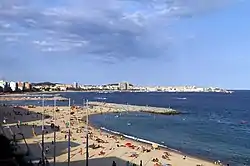Sant Antoni de Calonge | |
|---|---|
 Sant Antoni de Calonge | |
 Coat of arms | |
 Sant Antoni de Calonge  Sant Antoni de Calonge  Sant Antoni de Calonge | |
| Coordinates: 41°50′47″N 3°05′56″E / 41.84639°N 3.09889°E | |
| Country | |
| Community | |
| Province | Girona |
| Comarca | Baix Empordà |
| Municipality | Calonge |
| Time zone | UTC+1 (CET) |
| • Summer (DST) | UTC+2 (CEST) |
| Website | http://www.calonge.cat |
Sant Antoni de Calonge is a town which forms part of the city of Calonge. It is located in the comarca of the Baix Empordà in Catalonia, Spain. The town was built along the rocky coastline of northern Spain. There is a seaside promenade that connects many neighboring towns. Sant Antoni de Calonge is between Platja d'Aro and Palamós.[1]
History
Pre-history
In ancient times, Sant Antoni de Calonge served as a summer retreat for the Romans. Construction on the fortress in Calonge dates back to the 8th century.[2] The church of St. Daniel and a Roman road are the two oldest buildings of architectural value still standing in Sant Antoni. The church of St Daniel dates back to the sixteenth or seventeenth century.[3] Additionally, there are some ruins, megaliths, Chalcolithic burial caves, and ancient artifacts scattered across the coastline and housed in the Archaeological Museum of Calonge.[3] This archaeological evidence suggests the area was inhabited during the periods of Prehistoric Iberia and the Roman Empire.[3]
Modern history
Sant Antoni did not begin to develop as a separate town until fishing villages began populating the Spanish coast in the late eighteenth century with the decline of piracy.[3] With few ancient structures to impede development, most buildings in Sant Antoni are from the twentieth century, although some homes date back to the eighteenth and nineteenth centuries.[3] The Neo-Gothic church of Saint Anthony was built in 1936.[4] Sant Antoni de Calonge is now under the municipality of Calonge. However, it was an autonomous town in 1936 under the name, San Antonio de Mar[4] and later Levantine Sea.[4] This autonomy only lasted during the Spanish Civil War, from 1936 until 1939.[4]
Tourism
In summer Sant Antoni de Calonge draws crowds of water sport enthusiasts and vacationers from across Catalonia.
In 2011 Sant Antoni de Calonge hosted a photo contest which utilized five giant frames located around the city. These frames are still in place and serve as markers for many of the most picturesque scenes in Sant Antoni.
The GR 92 long distance footpath, which runs the length of the Mediterranean coast of Spain, passes along the seafront promenade of Sant Antoni de Calonge. To the north the path continues along the promenade to Palamós, whilst to the south it follows the rocky coastline and crosses several beaches to reach the northern end of the beach at Platja d'Aro.[1]
References
Bibliography
- "Destaquem" Sant Antoni De Calonge. N.p., n.d. Web. 20 Feb. 2013.
- "Ajuntament De Calonge" Ajuntament De Calonge. N.p., n.d. Web. 20 Feb. 2013
- "History" Ajuntament De Calonge. N.p., n.d. Web. 20 Feb. 2013.
- "Sant Antoni De Calonge" Sant Antoni De Calonge. N.p., n.d. Web. 20 Feb. 2013
- "Calonge" Enciclopèdia.cat. N.p., n.d. Web. 20 Feb. 2013
- "Sant Antoni de Calonge" Enciclopèdia.cat. N.p., n.d. Web. 20 Feb. 2013
External links
- "Sant Antoni De Calonge" - Guide to Calonge and. N.p., n.d. Web. 20 Feb. 2013.
Notes
- 1 2 Empordà Costa Brava - Sud (Map). 1:30,000. Editorial PIOLET i Consell Comarcal del Baix Empordà. March 2012.
- ↑ "Thinks to do in Calonge – Sant Antoni?". Sant Antoni de Calonge. Ajuntament de Calonge. Retrieved 20 February 2013.
- 1 2 3 4 5 "Calonge". Enciclopèdia.cat. Grup Enciclopèdia Catalana. Retrieved 20 February 2013.
- 1 2 3 4 "Sant Antoni de Calonge". Enciclopèdia.cat. Grup Enciclopèdia Catalana. Retrieved 20 February 2013.